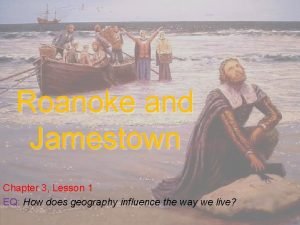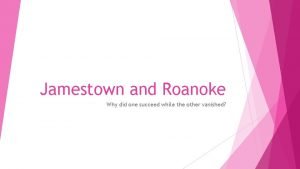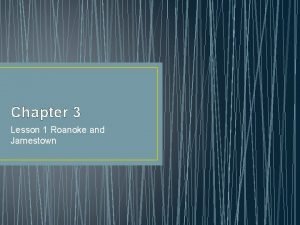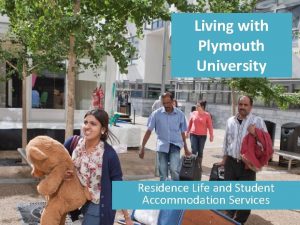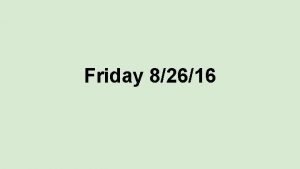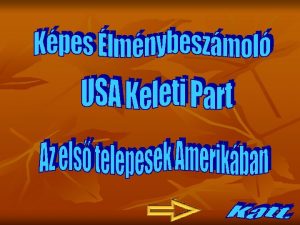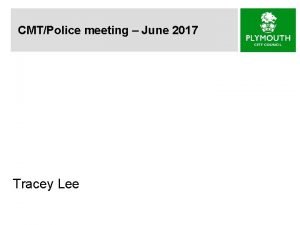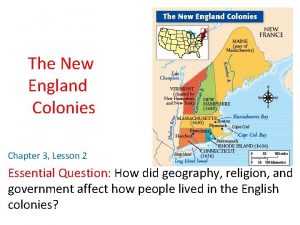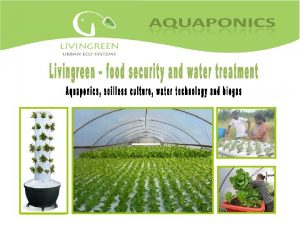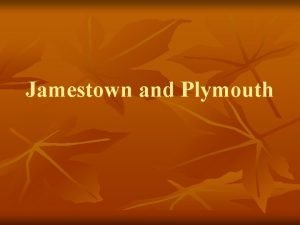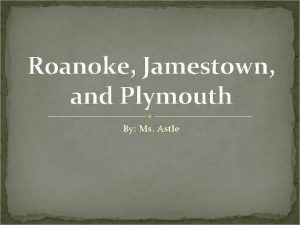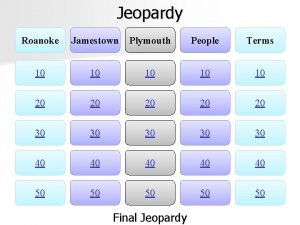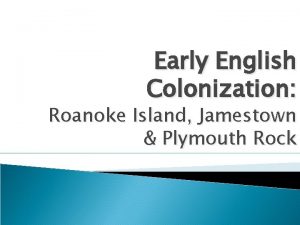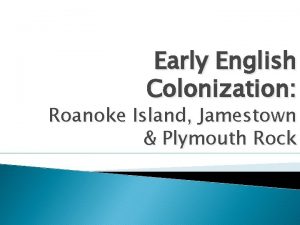LIVIN LIFE IN ROANOKE JAMESTOWN AND PLYMOUTH ROANOKE












- Slides: 12

LIVIN’ LIFE IN ROANOKE, JAMESTOWN, AND PLYMOUTH

ROANOKE- QUICK FACTS • It was the first colony in the new world, located on an Island near the coast of North Carolina. • The land was first explored by the English in 1584. They reported there was fish, animals, fruits, vegetables, and friendly Natives. • Captain John White and over 100 English settlers came back and formed the colony in 1587. • Why did they come? –In search for a better life. • Supplies were low and there were few farmers on the ships. • White went back to England to get more supplies. • Due to the war with Spain, he didn’t return to Roanoke for another 3 years. • Roanoke was completely empty, and no one knows what happened. Learn more about the mystery of Roanoke

Jamestown- quick facts • In 1607, 105 wealthy men came from England to the New World and settled in Virginia. • Jamestown was named after King James of England. • Jamestown was unknowingly formed on a marsh (wet, low-lying land that is poorly drained). • They created a fort surrounding the settlement for protection. • Why did they come? –In search of gold. • This is where the famous John Smith settled, who was befriended by the Native American, Pocahontas.

The Real Pocahontas and John Smith http: //2. bp. blogspot. com/Rlvuh 8 msy 7 M/TZn. Fb. IPVl 5 I/AAAAAME/E 1 D Ds 8 h 84 i. M/s 1600/Pocahontas. jpg http: //stricklandinternational. com/websites/caledo niankitchen/real-pocahontas-and-john-smith 8012. jpg

PLYMOUTH- QUICK FACTS • The 3 rd English colony. • Founded by English Separatists (people who refused to be apart of the Church of England), also known as “Pilgrims. ” • Came on the Mayflower in 1620 and landed in Massachusetts. • Why did they come? –For religious freedom. • The Pilgrims came to Plymouth in the winter. Nearly half died within the first few months due to disease and starvation. • The Pawtuxet tribe taught them how to plant corn, catch fish, and make maple syrup. • The Pilgrims made a peace treaty with the Wampanoags tribe. They celebrated the harvest together in the fall. We call this Thanksgiving Day. www. newton. k 12. ks. us/tech/13 colonies. htm

LIFE IN ROANOKE • The colonists brought fatal diseases with them to the new land. • Very harsh winters. • Lots of land for hunting and farming, but many of the colonists were not experienced doing either. • Friendly Natives close by to trade with. • Few supplies. • They made brick out of clay for housing, and also used wood for cabins. • Not much else is known about life in Roanoke due to the lack of survivors. • However, they know nothing about the day to day lifestyle that was severe enough to make the colony disappear. So , it was likely life was very similar to the other colonies.

LIFE IN JAMESTOWN • Diseases continued to spread. • Winters were harsh. • The women were responsible for gardening, smoking meat, milking cows, making clothes and cleaning. They would can food and spin and weave thread. • The men were responsible for planting crops, building fences, and butchering cattle and hogs. A comfortable farmer in the north owned about ten cattle, sixteen sheep, six pigs, two horses, and a team of oxen. • They drank cider and rum and loved to eat ham. • They never found real gold, but they grew tobacco which became very popular and valuable. Take a look at life in the beginning years of Jamestown

LIFE IN PLYMOUTH • Disease prevalent. • Harsh winters. • The people were mainly farmers. • They kept pigs, cattle, sheep, pigs, and chickens. The animals provided meat, eggs, milk, and wool for clothing. . • The men worked in the fields all day and grew crops like corn. • Women cleaned, milked cows, made soap, cooked, cared for the children and made clothes. • Children helped their parents and learned to work at a very young age. http: //spitballarmy. com/? p=10412

Roanoke DISCUSSION QUESTIONS… What similarities did you notice between and across colonies? What are some differences? Which colony would you want to live in? Why? Plymouth Jamestown http: //www. sjsapush. com/ch 2. php www. teacher-web. com www. lost-colony. com

NOW WHAT? Break up into 6 groups and create an advertisement for your assigned colony to try and get people to move there. If you are assigned Roanoke you have the option make a CAUTION sign instead because of the fact it is “The Lost Colony, ” and there were no survivors. Use your text books to help you.

LASTLY…. . Create a triple Venn Diagram for the 3 colonies! Roanok e Jamestow n Plymouth

ADDITIONAL RESOURCES USED http: //www. east-buc. k 12. ia. us/00_ http: //suite 101. com/article/plimoth-plantation-daily-life-a 137409
 Similarities between roanoke and plymouth
Similarities between roanoke and plymouth Lesson 1 roanoke and jamestown answer key
Lesson 1 roanoke and jamestown answer key Why did roanoke fail and jamestown succeed
Why did roanoke fail and jamestown succeed Colonial america lesson 1 roanoke and jamestown
Colonial america lesson 1 roanoke and jamestown Gilwell halls plymouth
Gilwell halls plymouth Plymouth plantation summary
Plymouth plantation summary Plymouth university dle
Plymouth university dle Beyond borders plymouth
Beyond borders plymouth Plymouth amerika
Plymouth amerika Kete new plymouth
Kete new plymouth Tracey lee plymouth
Tracey lee plymouth Conk hair watsons go to birmingham
Conk hair watsons go to birmingham Where is plymouth
Where is plymouth

